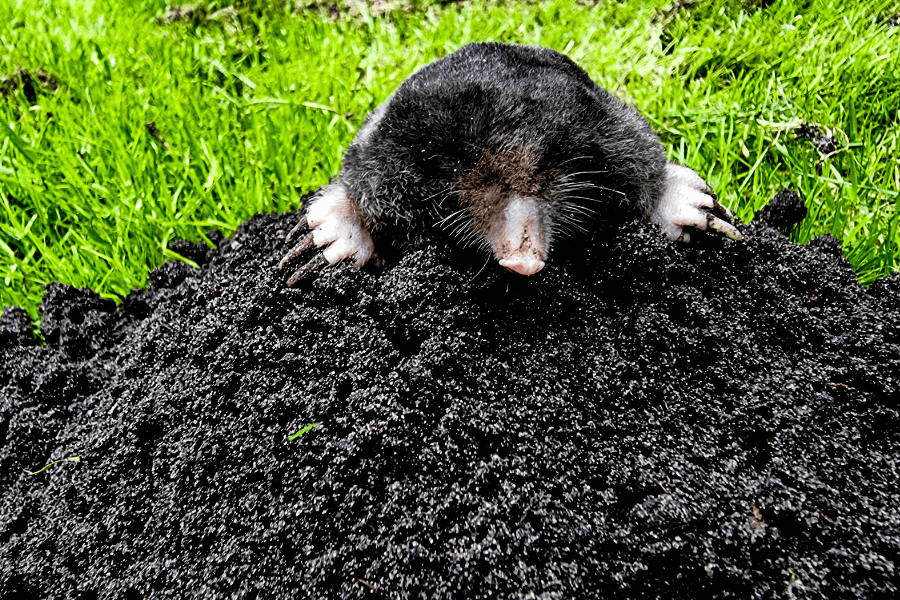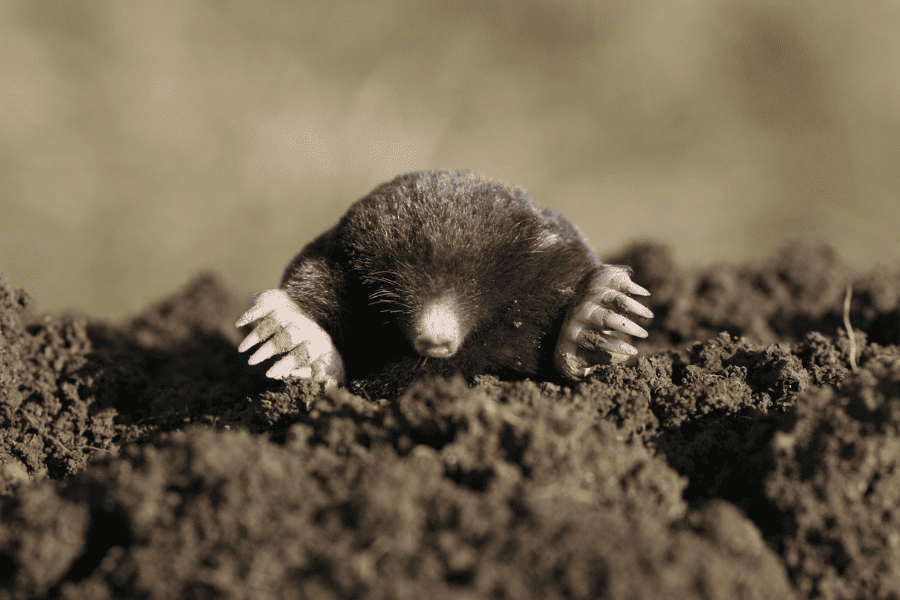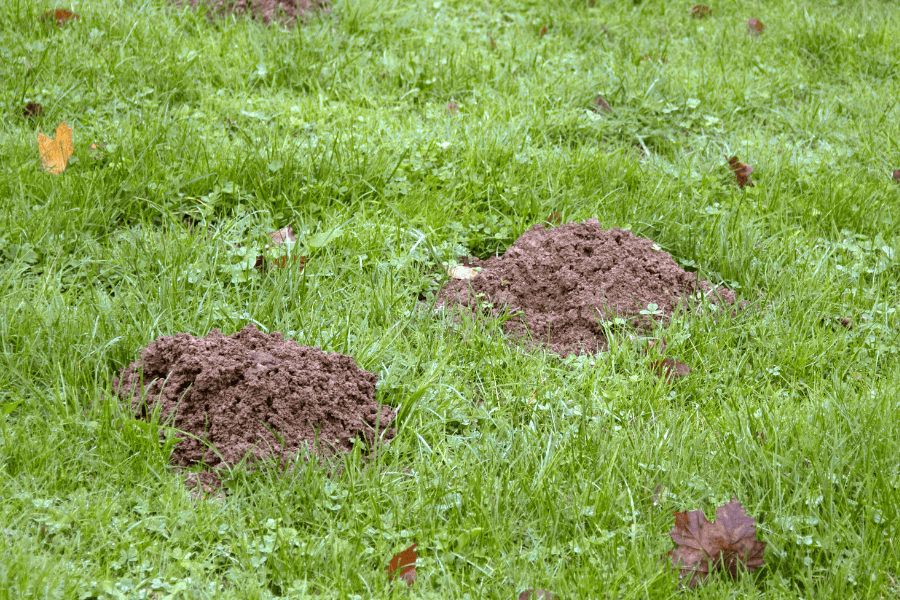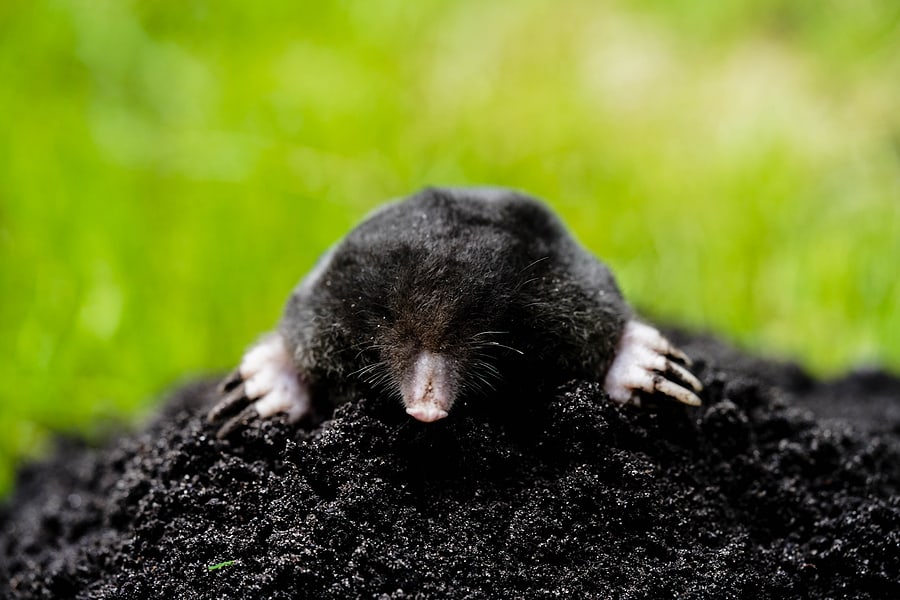READY TO GET STARTED?
REQUEST A FREE ESTIMATE
Fill out the form below or call (888) 466-7849 for a free, no-obligation estimate.

Moles can be one of the most destructive pests for yards. Once these creatures invade, they will dig and destroy your yard! One of the best steps for mole prevention on your property is understanding what’s bringing them there in the first place.
Moles are looking for one thing in on your property – food! Moles need a plenty amount of food source to survive and tend to eat various lawn insects, including grubs, earthworms, and other bugs. If you have available food sources in your yard, they will dig through to get it and leave behind tunnels, holes, and mounds of dirt. Moles can dig up to 18 feet per hours and as they are digging will detach the roots of plants to not only allow weeds to grow but will also kill the lawn, plants, and trees too.
Some common signs that a mole has invaded your yard include,
Mole prevention starts with reducing the sources that are attracting them in the first place. Check out our do-it-yourself mole control tips:
If you suspect a mole infestation on your property or other wildlife creatures, contact your local pest control company for a free evaluation.

Georgia homeowners take pride in their yard and spend money and time to perfect it, which is why having a mole infestation can be so frustrating. Moles are looking to your home for a food source and will dig up your manicured lawn in the process! Understand moles and how you can prevent them from invading your Georgia property in this blog.
Moles are small animals, ranging between 4 and 11 inches in length, can weigh up to 8 ounces, and have a grey to brown body color. They have a small pair of eyes, and no external ears and are often known for their long, thin, and hairless snout. Moles don’t have the best vision but have an exceptional sense of smell. These creatures also have large front feet with webbed toes, which helps them burrow underground and search for food.
Moles invade yards for one reason – to search for food. If they’ve sensed food on your property, they will dig underground to find it. Moles’ diets consist of many lawn pests, including grubs, earthworms, mole crickets, and ants. These creatures also prefer damp earth as well. Once they’ve found a food source in your yard, they will create tunnels underground, damaging root systems of your grass.
The best way to avoid moles is to make your yard undesirable to them. Check out our top mole prevention tips for Georgia yards:
A mole infestation can happen quickly and can be difficult to control and eliminate. The best and most effective way to remove and control moles is to contact your local wildlife control and pest control company for help. These pest professionals will set you up with an ongoing pest control service and schedule visits to identify the mole problem early and provide you with a treatment and prevention plan.

A perfectly manicured yard can be destroyed by moles in an instant! These creatures dig tunnels in search of lawn pests in your yard, including grubs, earthworms, and other bugs. Once moles invade, it can be difficult to control and remove them from your property as they can go undetected for long periods of time. One of the best ways to understand mole prevention is understanding the signs of their activity in the first place. We break down common mole signs and the preventative measures to place at your home to avoid their destruction.
There’s no one sign that can pinpoint moles in your yard but there’s several to lookout for if you suspect you’ve got a mole infestation, including:
If you’ve noticed any or all of these signs on your property, it’s likely that you have a mole in your yard.
There are several methods you can utilize to avoid mole activity. Consider the following mole control tips and tricks:
Since moles live underground, it can be difficult to prevent and control them. The best treatment for moles is target elimination through baiting, which is best done by a professional wildlife control company. These expert professionals will be able to track the mole, strategically place traps, utilize effective baits, treat the mole tunnels to avoid another mole infestation, and monitor the tunnels to ensure all moles have been removed. If you suspect moles in your yard, call your local wildlife control company for a free evaluation.

Moles can destroy your perfectly manicured lawn in a matter of days. These small, burrowing insectivores can be found in North America, Europe, and Asia. While they don’t actually eat plants and roots, their burrowing causes significant damage to both lawns and flower beds. Moles can dig up to 18 feet per hour and are most active in early morning and evening.
Moles are small in size, ranging between 4 and 11 inches in length and weighing up to 8 ounces. They are most notable for their long, thin, hairless snouts, small eyes, and lack of external ears. They are usually greyish-brown in color. Moles have large, powerful front feet with webbed toes that they use for burrowing underground while their hindfeet are narrow with slender claws. Moles are nearly blind but they make up for their lack of vision with an exceptional sense of smell.
Moles come into your yard in search of one thing – food! Their diet consists primarily of earthworms and grubs but they will eat other soil-dwelling insects, as well. Moles leave behind a trail of damage when they burrow in your yard, leaving visible trails and brown patches and holes in your lawn. Their tunnels cave in easily, leaving you at risk for injury when you step on them.
Some of the most common signs of moles in your yard are:
Because moles live underground they can be extremely difficult to prevent. The best treatment for moles is targeted elimination usually through trapping or baiting. It is also important to treat existing tunnels so new moles don’t replace the previously removed moles.
If you have a problem with moles or any other pests, contact your local pest control company who can properly assess your situation and treat it appropriately.
How to Prevent Little Black Ants
Is Green Mosquito Control Safe?

The last thing any homeowner wants is damage to their yard after all the hard work they’ve put in to get it just right. One of the most destructive pests to yards is the mole. What attracts moles to your yard? How do you get rid of them?
Moles are burrowing insectivores, feasting on a wide variety of lawn insects. They are usually about 6 to 8 inches long with gray to black velvety fur. Moles have slender, hairless snouts and small eyes and ears. They have large front feet with long claws that they use to dig through the dirt. They breed in early spring and are most active then and in the fall. Other than during mating season, moles prefer to be alone; if you have a mole problem you are usually only dealing with one.
Moles are attracted to food sources in your yard, digging through leaving behind tunnels, holes, and mounds of dirt. Moles require quite a bit of food to survive. Common signs of moles include: surface tunnels, dying grass and plants, an increase in weeds, and molehills (which are piles of dirt less than 6 inches tall and shaped like footballs or volcanoes). Moles can dig up to 18 feet per hour. As they dig they detach the roots of plants which not only allows weeds to take root but also kills the lawn, plants, and trees.
If you have a problem with moles or any other wildlife, contact your local pest control company for a comprehensive evaluation and elimination plan.
Fall Pest Control: Oriental Cockroaches